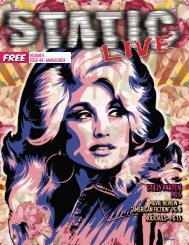Static Live Magazine February 2020
STATIC LIVE Magazine is Central Florida’s premier publication dedicated to celebrating music and culture. STATIC LIVE provides extensive, detailed community information from fashion to art, entertainment to events through noteworthy interviews, sensational photography and in-depth editorial coverage. STATIC LIVE is the only publication of its kind in Central Florida and reaches all target markets through wide distribution channels. Our staff includes highly accomplished contributors with award-winning backgrounds in music and entertainment; we know how much business is captured from the entertainment market. Our free full color publication can be found throughout Central Florida at key retailers, hotels and restaurants in high traffic areas. Our mission is to highlight the incredible talent, culture and lifestyle in Central Florida. With eye-opening profiles and coverage of the music and art community, STATIC LIVE readers will be positively influenced by our topical content and trending advertisers. STATIC LIVE Magazine is the most effective tool for branding connectivity with consumers in our area.
STATIC LIVE Magazine is Central Florida’s premier publication dedicated to celebrating music and culture. STATIC LIVE provides extensive, detailed community information from fashion to art, entertainment to events through noteworthy interviews, sensational photography and in-depth editorial coverage. STATIC LIVE is the only publication of its kind in Central Florida and reaches all target markets through wide distribution channels. Our staff includes highly accomplished contributors with award-winning backgrounds in music and entertainment; we know how much business is captured from the entertainment market. Our free full color publication can be found throughout Central Florida at key retailers, hotels and restaurants in high traffic areas. Our mission is to highlight the incredible talent, culture and lifestyle in Central Florida. With eye-opening profiles and coverage of the music and art community, STATIC LIVE readers will be positively influenced by our topical content and trending advertisers. STATIC LIVE Magazine is the most effective tool for branding connectivity with consumers in our area.
Create successful ePaper yourself
Turn your PDF publications into a flip-book with our unique Google optimized e-Paper software.
HIGH IN<br />
CHINA<br />
By Hank Harrison<br />
paper manufacturing in China, so the chances that the<br />
plant was also used for its euphoric effects are more<br />
than just probable. Switches and branches of the<br />
Mulberry tree are still used worldwide to make strong<br />
and especially large wicker baskets and are often<br />
blended with hemp to make ropes and bumpers for<br />
old-style ships, known as Dhows, which are still in use<br />
on the Nile.<br />
Cannabis plants and seeds have been identified at<br />
other archaeological sites in the region. A thousand<br />
miles to the east - almost to Russia - in the Jiayi<br />
Cemetery of Turpa - a cannabis ‘burial shroud’ woven<br />
into a mat, was discovered during excavations in<br />
2016. These were the first complete cannabis plants<br />
found in a human burial in China, and date from<br />
the sixth to the eighth century BC. Turpan was an<br />
important stop on the Silk Road; inhabited in ancient<br />
times by the Subeixi culture, also known as the Gushi<br />
Kingdom. But again; the Subeixi, like the Tibetans,<br />
still exist as an ethnic minority and are currently being<br />
censored by Beijing so who knows exactly what will<br />
come of this research.<br />
Marijuana has become a big problem<br />
in China, especially in ethnic districts<br />
like Tibet and Mongolia, where pot<br />
has been used in folk remedies for<br />
centuries. The Beijing Government<br />
insists on using its “Reeducation”<br />
programs to brainwash the old ways out of the<br />
modern population; and therein lies a dilemma. The<br />
central government bans Cannabis on the assumption<br />
that any form of euphoria or self-cure is delinquent or<br />
irrational and anti-social and, by policy, often punishes<br />
users by fine or even with jail sentences.<br />
This makes it odd that an article would recently<br />
appear in a prestigious Chinese archaeology journal<br />
discussing the excavation of several graves containing<br />
cannabis and hashish incense burners buried with<br />
grave goods. This proves the history of cannabis<br />
cultivation goes back thousands of years in China -<br />
and possibly tens of thousands.<br />
Cannabis in all of its<br />
forms is an incredibly<br />
versatile plant and has<br />
been mixed in the Greek,<br />
Syrian and Chinese<br />
pharmacopeias with<br />
many other plants for<br />
human and veterinary<br />
medicines and to<br />
alleviate pain in humans<br />
and animals. In Europe and along Roman Imperial<br />
trade routes it was used with opium and fermented<br />
brews as well as mushrooms and rye-wort buffered<br />
with vinegar, (lysergic acid) to make a psychedelic<br />
compound, it is even speculated to have<br />
been used in the biblical Hysop mixed given<br />
to Jesus in a sponge on the cross.<br />
18<br />
In an even older and far more bizarre<br />
situation, the Egyptians used cannabis to compound<br />
mummia, which was employed as a preservation tar<br />
in the mummification process. The Ancient Greeks<br />
and Scythians used hash based compounds mixed<br />
with Wild Rue and Opium on the battlefield and sold<br />
it far and wide to their allies. Recent archaeology<br />
reveals that the hash plant was connected to a<br />
ritual compounding process in Latakia, Syria and in<br />
Northwestern China, at least 4000 years ago and<br />
probably much earlier.<br />
Although the current Chinese government does not<br />
want to brag about it, recent evidence was presented<br />
in an international journal demonstrating that weed<br />
was used long ago in China. The journal emphasizes<br />
its strong fibers were used to create burial mats and<br />
horse collars and even cart ropes well before 1100<br />
BC. But this is where modern censorship comes in.<br />
The journal article avoids mention of any euphoric<br />
quality; clearly, the government wants to stress a<br />
kind of puritanical conformity throughout the entire<br />
country. We know people got high on weed based on<br />
the artifacts they left behind in many graves! In fact,<br />
2000 years ago, China was known as “the land of<br />
mulberry and cannabis” because of the abundance of<br />
these plants seen along the various salt routes and<br />
silk trade roads. Mulberry and cannabis were used in<br />
The earliest direct evidence in Asia for the<br />
consumption of cannabis as a medicine has recently<br />
been discovered in a 2500-year-old cemetery in the<br />
far west of China. The practice of getting high on it<br />
goes back much further and still goes on in remote<br />
villages - but the government doesn’t want you to<br />
know that.<br />
An international team of researchers analyzed the<br />
contents of ten wooden bowls excavated from burials<br />
at the Jirzankal Cemetery, a site on the Pamir Plateau<br />
in China (see map). The bowls contained small stones<br />
that had been exposed to high heat, identifying them<br />
as incense burners. The research was published in<br />
Science Advances in June 2019 (open access). The<br />
Chinese government refused to allow the researchers<br />
to speculate on the uses of the compounds found;<br />
but it seems obvious that any ritual use of any herb,<br />
anywhere on earth, is ultimately going to be linked to<br />
healing and getting high, or expanding consciousness<br />
in some way.<br />
Remarkably, the recent Jirzankal cannabis samples<br />
featured the highest levels of THC; yet detected<br />
at an ancient site, suggesting that people were<br />
intentionally cultivating hybrid cannabis for its strength<br />
and euphoric properties. However, I repeat; the<br />
inhalation of cannabis smoke from a heat source was<br />
well known to the Greeks and Egyptians. The Greek<br />
historian Herodotus, in the fifth century BC, relates<br />
that the horse worshipping Scythian; a nomadic tribe<br />
from the Steppes, used cannabis in “Vapor Baths” and<br />
burial rituals.<br />
The Scythians prized the<br />
resin from the flowering<br />
plants above gold and<br />
transported the compound<br />
in decorated urns. Various<br />
ritual vessels discovered in<br />
2013 in the burial mound of<br />
a Scythian Queen buried<br />
with her horses and chariot,<br />
were found to contain traces<br />
of both opium and<br />
marijuana; suggesting that they inhaled the<br />
hashish along with opium or mixed them in a<br />
drink or both.<br />
19


















